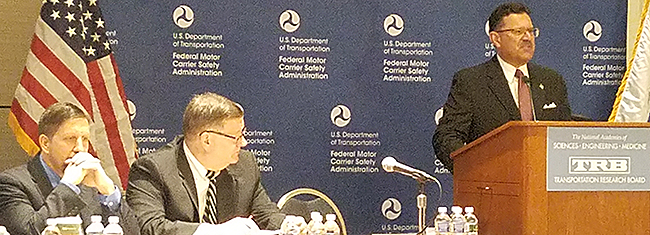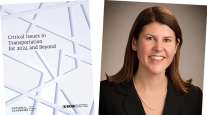Senior Reporter
FMCSA Says Rate of Truck-Occupant Deaths and Fatal Crashes Continues to Climb

WASHINGTON — Federal trucking regulators expressed concern over increasing numbers of large-truck-involved fatal crashes in work zones and a continuing increase in the number of fatalities of large-truck occupants.
Speaking at a Jan. 15 session of the 2019 Transportation Research Board Annual Meeting, Jack Van Steenburg, chief safety officer for the Federal Motor Carrier Safety Administration, said the number of large-truck-occupant fatalities increased to 841 in 2017 from 725 in 2016 and 665 in 2015. Roughly 38% of those victims in occupant fatalities were not wearing their seat belts, he said.
Likewise, the percentage of fatal work zone crashes that involved at least one large truck increased to 30.4% in 2017, up from 27.2% the prior year and 26.8% in 2015, Van Steenburg said.

FMCSA panelists (left to right) Joe DeLorenzo, Jack Van Steenburg and Ray Martinez by Eric Miller/Transport Topics
The percentage of all fatal crashes involving at least one large truck also rose to 12.4% in 2017 from 11.2% in 2016 and 11.1% in 2015.
Overall, the number of fatalities in large truck and/or bus crashes increased to 5,005 in 2017 from 4,629 in 2016, Van Steenburg said. The actual number of large truck and bus fatal crashes rose to 4,455 in 2017 from 4,116 the prior year.
The top five driver-related factors for large trucks and buses in fatal crashes were speeding, distractions such as cell phones, failure to yield right of way, impairment (fatigue) and careless driving.
“So we have some work to do,” Van Steenburg said.
FMCSA Administrator Ray Martinez said that some of that work to be done is included in the agency’s safety priorities in 2019. They will include inputting more accurate and timely crash data, evaluating tools to help drivers know when they are fatigued, continuing research on the promise of platooning, and supporting research and adoption of technologies for automated driving systems.
“Streamlined data collection and analysis will support safety improvements which can directly benefit the motoring public,” Martinez said.
Martinez added, “We all know about the human factor in crashes. You hear drivers say that they know when they’re tired. That’s not necessarily true.”
Martinez said that one of the things he likes about the quest to create driverless commercial vehicles is the technological journey that will improve safety along the way.
We all know about the human factor in crashes. You hear drivers say that they know when they’re tired. That’s not necessarily true.
— FMCSA Administrator Ray Martinez
“This may not impact the industry right now,” he said. “But as a government regulator there are decisions we have to make now, and in the coming years that will allow the United States to be on firm ground with continued development of these technologies.”
In 2019, the agency plans to continue its second year of study on a new method to improve the Compliance, Safety, Accountability Safety Measurement System using what is known as the Item Response Theory model recommended in a 2017 study by the National Academy of Sciences.
The model, expected to take at least two years before implementation, is expected to use data for informed policy decisions that are currently largely based on expert judgment, said Joe DeLorenzo, director of FMCSA’s office of enforcement and compliance.
“The model can see things not apparent to our expert judgment,” DeLorenzo told an audience of about 200. “The general construct will likely remain the same but the BASICs may change.”
(BASICs are the agency’s seven Behavior Analysis and Safety Improvement Categories used to compile CSA scores.)

DeLorenzo
DeLorenzo said the agency plans to conduct a small-scale data test in the next few months using the IRT model.
DeLorenzo also said that hours-of-service compliance has improved since the electronic logging device rule began being enforced last April 1. Less than 1% (17,651) of all driver inspections (2.3 million) has resulted in the driver being cited for operating without a required ELD or grandfathered-in automated on-board recording device, he said.
Steven Smith, director of the agency’s Office of Analysis, Research and Technology, said FMCSA has several ongoing research projects, including:
- A commercial driver pilot program for military-trained drivers.
- A study on commercial motor vehicle driver commuting.
- Formation of a working group to review the data elements for tow-away crashes.
- A study about the safety and enforcement impact of exemptions.
- Research to support FMCSA’s Beyond Compliance Program.





